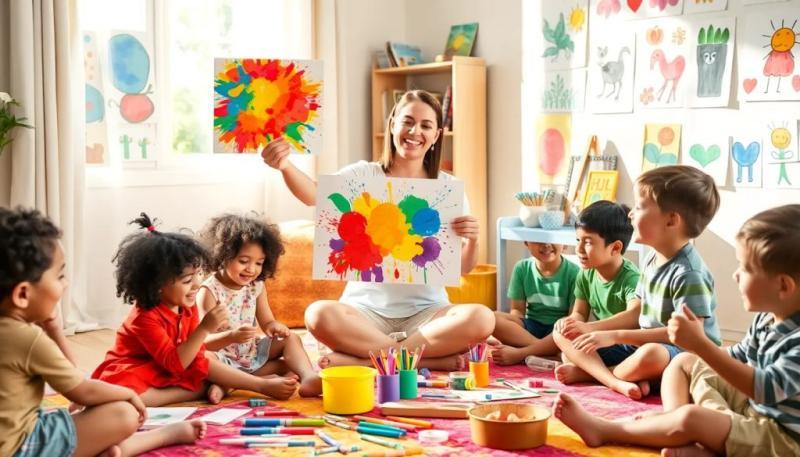Creativity is a fundamental aspect of childhood development that extends beyond mere artistic expression. It plays a vital role in building problem-solving skills, fostering self-expression, and enhancing cognitive development. This article explores how babysitters can effectively encourage creativity in children through engaging activities and a supportive environment.
In many instances, babysitters become a child's primary mentor during crucial learning years. Thus, understanding methods like creative projects for kids during babysitting can significantly impact a child's growth and imagination.
Why is creativity important for children?
Creativity is essential for children as it aids in their cognitive development. Engaging in creative activities helps children develop critical thinking and problem-solving skills, enabling them to tackle challenges effectively. Moreover, it fosters an environment for self-expression, allowing children to articulate their thoughts and feelings through various forms of creativity.
Additionally, children who engage in creative activities tend to show improved emotional intelligence. They learn to understand and express complex emotions, which is crucial for social interactions. Enhancing creativity not only benefits their artistic skills but also contributes to their overall well-being.
Furthermore, fostering creativity helps children become adaptable and resilient. In a world that constantly changes, the ability to think creatively enables them to navigate uncertainties and embrace new experiences with confidence.
What are some simple arts and crafts ideas for babysitting?
Babysitters can easily incorporate fun arts and crafts activities into their routines. Simple projects can be both enjoyable and educational for children. Some excellent ideas include:
- Messy art with edible paint: Using yogurt and food coloring, children can create colorful masterpieces without the mess of traditional paints.
- Nature collages: Collecting leaves, flowers, and twigs during outdoor play can ignite creativity while connecting them with nature.
- Cardboard constructions: Using recycled cardboard, children can build imaginative structures, fostering both creativity and problem-solving.
- Salt dough sculptures: Making salt dough is easy and allows children to mold their ideas into tangible forms, enhancing fine motor skills.
- Story stones: Painting stones with various images can encourage storytelling while incorporating imaginative play.
These activities are not only engaging but also help children develop important skills such as fine motor development and critical thinking.
How can babysitters incorporate educational aspects into creative activities?
Babysitters have a unique opportunity to blend education with creativity. Integrating educational elements into creative activities can enhance children's learning experience. For example, when creating a nature collage, a babysitter can discuss different types of leaves and flowers, teaching children about biodiversity.
Math can also be incorporated through arts and crafts. While creating patterns with beads or coloring shapes, children can learn about symmetry and counting. This approach helps children relate their creative projects to academic concepts in a fun way.
Another strategy is to encourage children to express their ideas and thoughts verbally during creative sessions. Asking questions like "What inspired your drawing?" or "Can you explain your sculpture?" nurtures their language skills while promoting encouraging imagination in young learners.
What engaging activities can foster creativity beyond arts and crafts?
Creativity can flourish in many forms beyond traditional arts and crafts. Here are some engaging activities that babysitters can implement:
- Imaginative play: Encourage children to participate in role-playing games, such as pretending to be a chef or a superhero, which enhances creativity and storytelling skills.
- Exploring museums: Visiting local museums can spark creativity by exposing children to art, history, and science in an interactive environment.
- Cooking together: Involving children in meal preparation not only teaches them about nutrition but also allows them to express creativity through food.
- Music and dance: Introducing children to different musical instruments or dance styles can inspire creativity and help with physical coordination.
- Gardening projects: Engaging children in gardening cultivates a sense of responsibility while allowing them to explore nature creatively.
These activities emphasize that creativity can manifest in various ways, encouraging children to explore their interests freely.
How to create a flexible environment for creative exploration?
A flexible environment plays a crucial role in encouraging creativity in children. It is essential for babysitters to provide a space where children feel safe to explore their ideas. One way to achieve this is by arranging materials that are easily accessible, allowing children to initiate their projects.
Additionally, setting up different activity stations can provide options, such as a reading nook, an art corner, or a construction zone. This variety stimulates curiosity and gives children the freedom to choose what interests them the most.
Moreover, encouraging children to express their preferences in activities can foster a sense of ownership over their creative process. Babysitters can ask, "What would you like to do today?" to help children feel more engaged in their learning.
What skills do arts and crafts activities help develop in kids?
Arts and crafts activities are instrumental in developing several key skills in children. These include:
- Problem-solving skills: Engaging in projects often requires children to think critically and develop solutions when challenges arise.
- Fine motor skills: Manipulating various materials enhances hand-eye coordination and dexterity.
- Self-expression: Children learn to convey their thoughts and feelings through creative projects, which builds their confidence.
- Social skills: Working in groups or sharing materials encourages children to collaborate and communicate effectively.
- Creative thinking: Regularly engaging in arts and crafts fosters innovative thinking and inspires new ideas.
Overall, these skills are vital for children's holistic development, setting a strong foundation for future learning and interactions.
Related questions about fostering creativity in children
How do you encourage children to be creative in childcare?
Encouraging creativity in childcare involves providing diverse opportunities for self-expression. This can be done through open-ended activities that allow children to explore their interests. For instance, offering various art supplies enables them to create without restrictions.
Additionally, engaging children in conversations about their ideas and creations helps validate their thoughts. When children feel heard, they are more likely to delve deeper into their creative processes and develop unique perspectives.
How to increase creativity in children?
To increase creativity in children, it's important to expose them to various experiences and activities. Incorporating frequent field trips or outdoor adventures can inspire new ideas and perspectives. This exposure broadens their horizons, encouraging them to think outside the box.
Moreover, fostering a culture of curiosity is crucial. Asking open-ended questions and encouraging discussions will stimulate children's imaginations and prompt them to explore different possibilities.
How do you promote children's creative learning?
Promoting children's creative learning involves integrating play with education. By blending learning with enjoyable activities, children can absorb new concepts while having fun. For example, storytelling sessions can be enhanced with puppets or props, allowing children to engage with the narrative actively.
Also, celebrating children's creative achievements, no matter how small, boosts their confidence and motivates them to continue exploring their creativity. Recognizing their efforts encourages a lifelong love for learning.
What do you learn from babysitting kids?
Babysitting provides valuable insights into children's developmental stages and personalities. Each child is unique, and observing their interactions can teach babysitters effective strategies to navigate various situations. Understanding children's preferences and interests enables caregivers to tailor activities that resonate with them.
Moreover, babysitting fosters adaptability and patience, as caregivers learn to respond to the evolving needs of children. This experience not only enhances their childcare skills but also enriches their understanding of childhood development.



